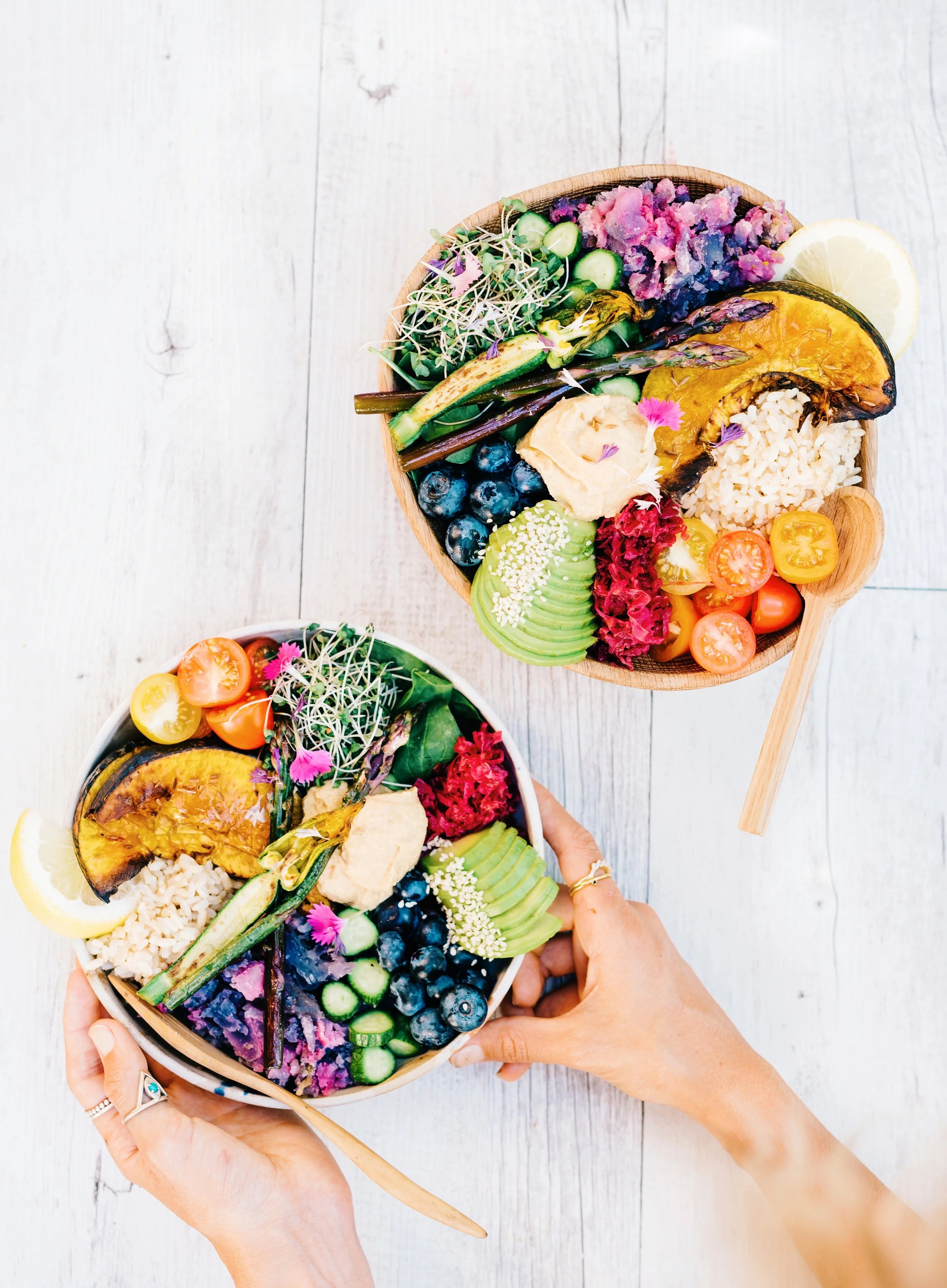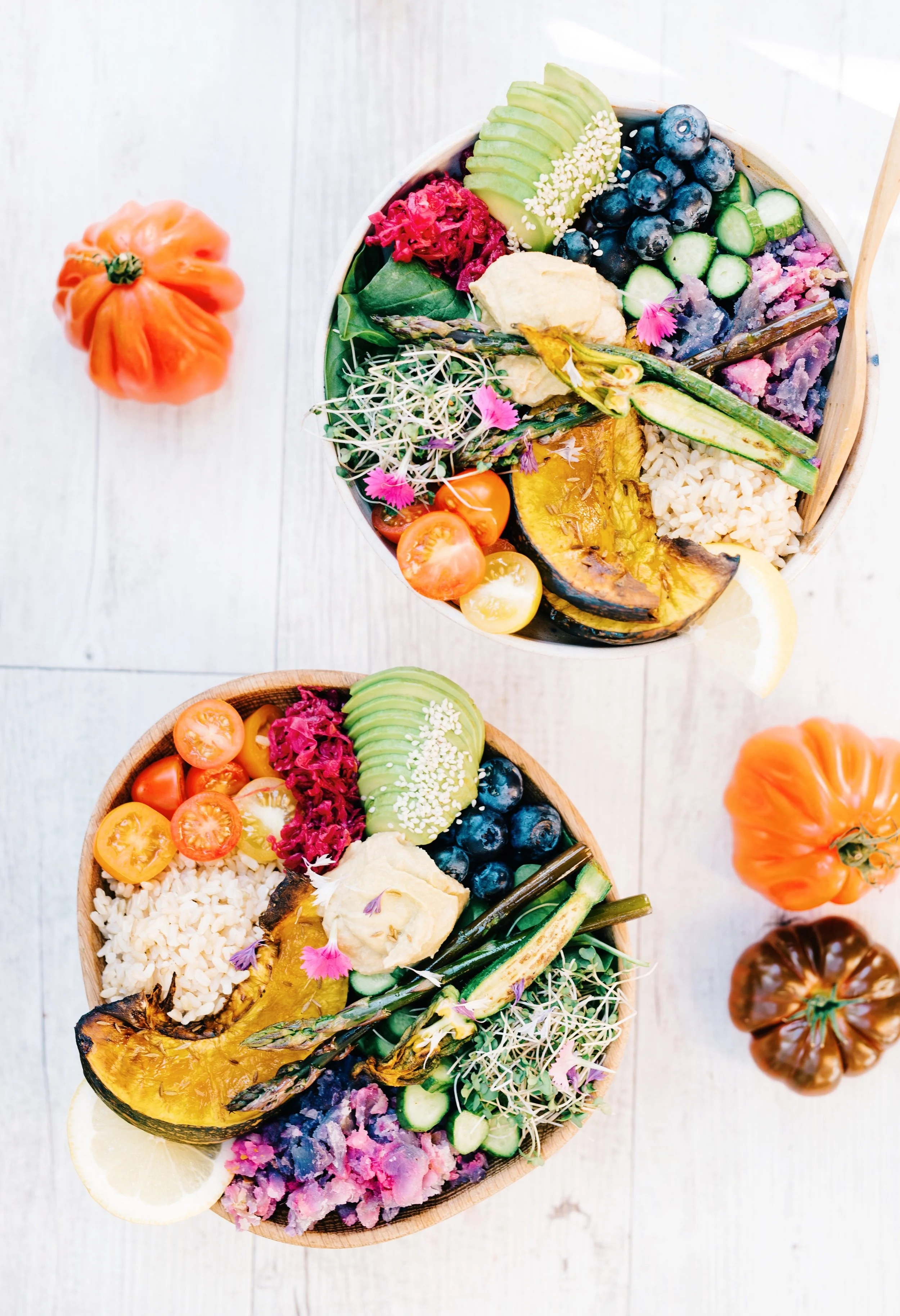Rainbow Buddha Bowl
Nourish bowls, Buddha bowls, Rainbow bowls, Macro bowls, whatever you want to call it, I am going to show you how to build the most nutritious bowl of plant based GOODNESS! It’s so easy and once you have the principles down pat you can start to experiment with loads of different combinations, flavours and give them a culture. These whole food bowls are designed to be a combination of different ingredients arranged in segmented piles and are based on eating an abundance of different foods with different nutrients giving you a complete meal! Only one in 20 Australians eat their recommended 5 serves of veggies per day, it's so important to start spreading the word on how people can do this! Making a Buddha bowl is one super easy way!
Here's how to build one:
Step 1. We need a grain!
Ignore all that bulls**t about cutting out grains, unless you have a serious disease (diagnosed) or you know that they cause an intolerance then there is no need to cut these guys out! Grains are one of the five food groups, they contain certain vitamins and minerals such as zinc, iron and the B vitamins (niacin, thiamin, folate and riboflavin) that you may not get enough from in other foods, they give you sustained energy throughout the day, and fibre to get those intestines moving along regularly! ALWAYS CHOOSE WHOLEGRAINS! This means minimal processing and still containing their outer husk/layers.
My favourite whole grain is brown rice (Australian grown) but you can mix it up. Try: buckwheat, couscous, barley and quinoa.
(If you think you may have an intolerance/experiencing severe gastrointestinal symptoms such as diarrhoea and pain then see your GP or book in to see a dietitian!)
Step 2. Add a plant based source of protein!
Yes, you can get protein from eating plant based. Legumes contains many of the same nutrients as meat! Such as protein, iron and zinc. They also contain fibre and no saturated fat (double whammy!).
I’ve served mine with home-made hummus (chickpeas). Try: whole chickpeas, lentils, kidney beans, black beans, garden peas, tempeh or tofu! You can eat them whole, mix with spices and bake as patties, or blend into a creamy paste.
Step 3. Create a rainbow of VEGGIES!
You probably hear this a lot- but why do we want you to eat a rainbow of them? Well vegetables are high in many different vitamins, minerals and antioxidants, as well as fibre and hydrating water. Each has a slightly different profile of nutrients. For example: dark leafy greens (such as spinach) contain iron, bright red veggies (such as tomatoes) contain vitamin C, and orange veggies (such as carrots) contain beta-carotene a pre-cursor for vitamin A. Eating a variety of different colours means you’ll be getting all the nutrients you need!
I like to add a starchy vegetable such as sweet potato (I have baked and mashed a purple sweet potato) as they are high in complex carbohydrates, so they keep you feeling fuller for longer. You could try baked sweet potato chips, baked potatoes or corn. I have also added baked pumpkin, cherry tomatoes, cucumber, asparagus, sprouts, spinach and zucchini flowers.
Step 4. Don’t forget them healthy fats
To make this meal complete we can’t forget the last macro-nutrient: FAT! But why do we need fats? Well firstly, when you consume fats they assist you to absorb other nutrients such as fat soluble vitamins (vitamin A, D, E, and K), we use them to produce hormones in the body, and fat is stored around organs to protect them from damage (like little shock absorbers). Fats line the layer around every single cell, so even just to grow and replace cells in our bodies we need them.
There are three broad groups of fat, two are naturally occurring: saturated and un-saturated. There is also trans-fats which occur through processing. When eating a whole food plant-based diet, you are unlikely to consume many trans-fats (if any). Saturated fats are also mainly from animal products and like trans-fats, are also linked to increased risk of heart disease. Then there is the un-saturated fats, these guys are the ‘good’ fats, we love these guys! When replacing saturated fats with un-saturated fats it reduces your risk of heart disease.
I like to add avocado to everything! They are so creamy and delicious. I have also added some sesame seeds and olive oil (in the hummus). You can also try some nuts such as almonds, cashews or walnuts, and other seeds such as pepitas or sunflower seeds.
Step 5. Try mixing in some fruit too!
Fruit is another one of the food groups that can be thrown in here for an extra kick of goodness. Like vegetables, fruits also contain loads of different micronutrients (vitamins and minerals), antioxidants, fibre and water! Some people feel adding fruit to savoury dishes is strange, but I love it! They add a burst of sweetness or sourness.
I have added some plump blueberries. You can also try: strawberries, pear, pomegranate, raspberries, orange or mango!
Step 6. Last but not least, for a little extra goodness: fermented foods!
There is a lot of talk lately about fermented foods and gut bacteria’s role in healthy digestion, absorption and illness (immunity). I think there is still a lot of evidence that will come up in the coming years but it’s an area I am really interested in! Prebiotics and probiotics are two nutrients that are involved in this area. Prebiotics come from the plant fibres of some everyday foods (such as bananas and oats) and feed the bacteria in your gut. If you eat a variety of different whole foods you will be sure to get enough of these to feed your own gut bacteria. Probiotics (or friendly bacteria) are contained in fermented foods such as kimchee, sauerkraut and kefir. They’re also in some yoghurts and fermented drinks such as kombucha. They grow in these foods through the fermentation process. It’s not known (yet) how much of it survives through the stomach acid to make it to your large intestine (where they live).
My favourite is a beetroot sauerkraut which is made from mainly cabbage. You can also try: kimchee, green sauerkraut, tempeh (fermented soy beans) and miso paste. But remember, you only need a little bit (maybe 2 teaspoons), its full of flavour and may be high in salt too.
So you see, once you have the principles worked out its really simple to create any kind of abundance bowl! They are a great way to use up leftover veggies in the fridge. You can even try experimenting with a different vegetable each time you create them! This was the first time I had cooked zucchini flowers :)
Elsa, xx
“eat good food, mostly plants!”



